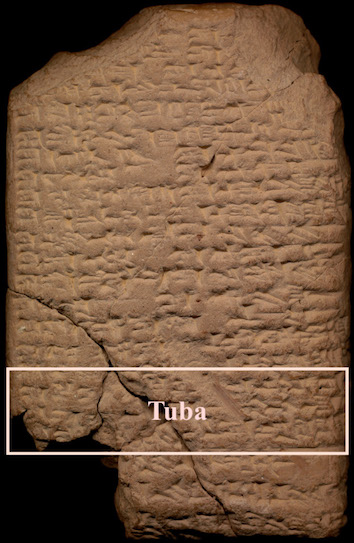Ekitušgarza (temple of Ištar as Bēlet-Eanna at Babylon)
Ekitušgarza was one of the three religious buildings in the Tuba district of West Babylon, at least according to Tablet IV of the scholarly compendium Tintir = Babylon. That temple was dedicated to the goddess Ištar in her manifestation as Bēlet-Eanna ("Lady of Eanna"). According to Akkadian inscriptions of the Neo-Babylonian king Nebuchadnezzar II (r. 604–562 BC), Ekitušgarza temple was located "in a corner of the city wall of Babylon" (Akkadian ina tubqāt dūr bābili), on the western bank.

Names and Spellings
This temple at Babylon went by the Sumerian ceremonial name Ekitušgarza, which means "House, Abode of Regulations." Some copies of Tintir = Babylon Tablet IV call the temple Egarza ("House of Regulations") or Ekisaduga ("House, Place of Regular Offerings").
- Written Forms: e₂-garza: e₂-ki-tuš-garza; e₂-ki-sa-dug₄-ga.
Known Builders
- Neo-Babylonian (ca. 625–539 BC)
- Nebuchadnezzar II (r. 604–562 BC)
Building History
Nebuchadnezzar II, the son and immediate successor of Nabopolassar (r. 625–505 BC), claims to have built many temples at Babylon, including two in the Tuba district of West Babylon: Ekitušgarza for Bēlet-Eanna and Esabad for the healing goddess Gula. Although this Neo-Babylonian king's inscriptions provide almost no information about the project itself, apart from the fact that he had the temple's brick superstructure raised to a great height, these texts do provide some topographic information about Ekitušgarza's location. A few texts record that it was in West Babylon — information known from scholarly compendium Tintir = Babylon — while others record that it was "in a corner of the city wall of Babylon" (Akkadian ina tubqāt dūr bābili). Because there was no location where the city walls Imgur-Enlil and Nēmetti-Enlil changed direction in the Tuba district, thereby creating a corner at the point where the walls met, it is often assumed that this temple of Bēlet-Eanna might have been near the corner of a large projecting tower, perhaps one belonging to the monumental Šamaš Gate, located on the southern stretch of the inner city wall, just west of the Arahtu River, the arm of the Euphrates River that ran through Babylon.
Archaeological Remains
Ekitušgarza has not yet been positively identified in the archaeological record.
Further Reading
- George, A.R. 1992. Babylonian Togographical Texts (Orientalia Lovaniensia Analecta 40), Leuven, pp. 330–331.
- George, A.R. 1993. House Most High. The Temples of Ancient Mesopotamia (Mesopotamian Civilizations 5), Winona Lake, p. 111 no. 621.
- Pedersén, O. 2021. Babylon: The Great City, Münster, p. 200.
Jamie Novotny & Joshua Meynell
Jamie Novotny & Joshua Meynell, 'Ekitušgarza (temple of Ištar as Bēlet-Eanna at Babylon)', Babylonian Temples and Monumental Architecture online (BTMAo), The BTMAo Project, a sub-project of MOCCI, [http://oracc.org/btmao/Babylon/TemplesandZiggurat/Ekitushgarza/]